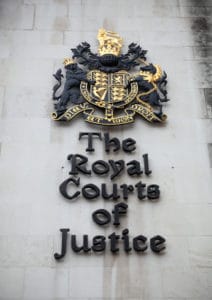
High Court: no basis for bias claim
A barrister accused of forging client care letters has lost an appeal against his disbarment at the High Court.
Mrs Justice Lang rejected Damian McCarthy’s argument that a Bar disciplinary tribunal was under pressure from the Bar Standards Board (BSB) to convict him, saying it was “inconceivable” that the tribunal would have been “improperly influenced” in this way.
Mr McCarthy argued that the pressure came from the suggestion of his guilt in a press release issued by the BSB in August 2015 and covered by Legal Futures and another legal publication, nearly a year before the hearing.
It came four years into this long-running case. Mr McCarthy was initially disbarred in 2011, following accusations that he had forged client-care letters when acting as a direct access barrister. The ruling was later upheld by the Visitors to the Inns of Court.
Mr McCarthy successfully overturned his disbarment at the Court of Appeal in 2015, where Lord Justice Burnett described a BSB official who failed to disclose a prosecution statement of “subverting the rules” and being “blind to any sense of fairness”.
The case was remitted to a fresh disciplinary tribunal – the point at which the press release was issued. But the tribunal last summer ruled that Mr McCarthy had “engaged in conduct in pursuit of his profession which was dishonest or otherwise discreditable to a barrister”, and disbarred him again.
In his appeal to the High Court, he claimed the press release was a breach of the presumption of innocence in article 6(2) of the European Convention of Human Rights and “grossly irregular because it expressed the opinion that he was guilty of dishonesty, despite the quashing of his conviction”.
Lang J responded in her ruling this week that the barrister could not “establish that any members” of the second tribunal actually saw the BSB press release or the articles in the legal press.
She said: “Legal and lay panellists on disciplinary tribunals are subject to stringent selection procedures to ensure that they are suitable for appointment. Once appointed, they are given training and written guidance on their role as adjudicators. They gain experience and expertise through sitting.
“For these reasons they are not comparable to jurors in a criminal trial. I have no doubt that this tribunal would have been well aware of the elementary principles that the BSB bore the burden of proving the appellant’s guilt, to the high criminal standard, and accordingly the appellant was innocent until proved guilty.”
However, the judge said she agreed that the BSB press release went “somewhat further than was proper, in expressing its view that the appellant had committed the offences with which he was charged”.
As conceded by counsel for the BSB, “it would have been better if the press release had been expressed in more circumspect language, confining itself to commenting on the strength of the evidence against the appellant”, she said.
Mr McCarthy also claimed that the second tribunal was biased because its chairman, HH Judge Hammerton, had been a pupil of HH Judge Crawford Lindsay QC, the chairman of the first disciplinary tribunal, whose decision Mr McCarthy had successfully appealed.
On bias, Lang J said “no fair-minded and informed observer would conclude that there was a real possibility” that HH Judge Hammerton, chair of the second tribunal would be biased, because her pupil master and former head of chambers had chaired the first tribunal.
“In comparison with many of the reported cases, HH Judge Crawford Lindsay QC’s link with this tribunal’s adjudication was remote. He was not a party to the proceedings, nor was he appearing as an advocate. HH Judge Hammerton was not hearing an appeal from his decision, and would not have to comment upon it or analyse it. It had not even been disclosed to the tribunal, and the panel had been asked to disregard it.
“Moreover, HH Judge Crawford Lindsay QC had not been the subject of any criticism, of which she was aware. The criticism and the basis of the successful appeal was the conduct of the BSB.”
Finally, Mr McCarthy argued that the tribunal “misdirected itself” on sanction, and suspension for two years would have been “fairer and more proportionate”.
Lang J said the disciplinary tribunal correctly “applied the guidance and did not misdirect themselves in law”. She dismissed Mr McCarthy’s appeal.
Marc Beaumont, counsel for Mr McCarthy, commented: “Mr McCarthy continues to protest his innocence. Clearly this decision is a terrible blow to him.
“We worked hard with very limited resources to try to win this appeal, doing so in the face of non-disclosure, as the judgment explains. In my view, the true extent of the way that unconscious bias operates on the minds of decision-makers is still not fully understood.
“Shutting a young, talented barrister out for all time is really tough on Damian, bearing in mind that other barristers in a not dissimilar position have been suspended rather than disbarred.”














Nick,
Is this DM the same as this guy
https://natemplaw.co.uk/meet-the-team/
and this guy
https://damianmccarthy.com/about-me/
Interesting, if so, that he is proud to say he’s no longer a member of the bar and of what he does not mention.